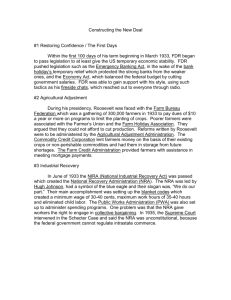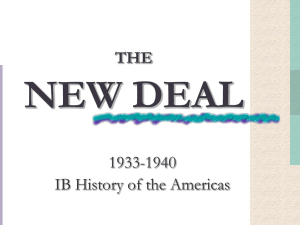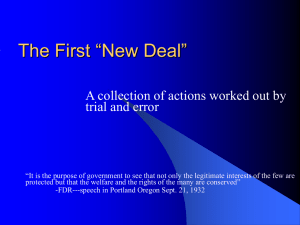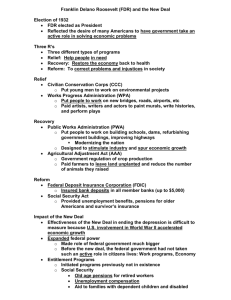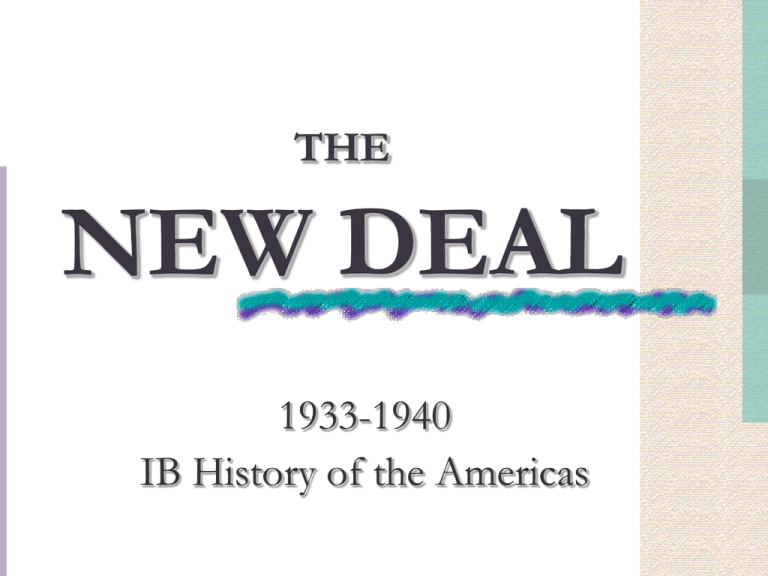
THE
NEW DEAL
1933-1940
IB History of the Americas
GUIDING QUESTIONS
How successful was the
Roosevelt Administration’s “New
Deal” in solving the problems of
the Great Depression?
(Consider: relief, Recovery, Reform; e.g. Agricultural Adjustment Act; Securities and Exchange Commission; Wagner National Labor Relations Act; Social Security Act)
How did it change the role of the federal
government?
How did it fashion a more stable economy and a
more equitable society?
FDR: A “NEW DEAL”
“A New Deal for the
American People”
"The only thing we have to
fear is fear itself.“
confidence, optimism,
public relations
“Fireside chats”
Eleanor Roosevelt
“Brains Trust”
Goals: “Three R’s” - relief,
recovery, reform
Roosevelt Delivering a Fireside Chat, 1935
“Brain Trusts”
FDR wanted to gather
around him all the
knowledgeable people
he could to help him
solve the problems
associated with the
Depression.
So, the group of
academics, or “Brain
Trust” developed
FDR's economic policy
and developed
programs that became
the backbone of the
New Deal.
Roosevelt’s Management Style
New Congress willing to pass almost anything Roosevelt
asked for
Much legislation was written by the “Brain
Trust”
Led by intuition; didn’t know exactly where he was going
He was a quarterback – next play depends on outcome of
previous play
Public was willing to support any action (even wrong)
over doing nothing
FDR Holding a Press Conference, 1939
Outline of the New Deal
Hundred Days focused on short-term
problems; long-term reforms came later
Passed many essential reforms that industrialized
Europe had had for years
Unemployment insurance, old-age insurance,
minimum-wage regulations, conservation and
development of natural resources, restrictions on
child labor
Eleanor Roosevelt visits West Virginia Coal Mine,
1933
Eleanor Roosevelt visiting a West Virginia Coal Mine, 1933
(c) Bettmann/Corbis
Copyright © Houghton Mifflin Company. All rights reserved.
First Hundred Days
Roosevelt acts decisively
March 6 – 10 – nationwide
banking holiday declared
Overwhelmingly
Democratic Congress
called into special session
March 9 – June 16, 1933 –
Hundred Days
Congress cranked out laws
to deal with Depression
Alphabet Agencies
In total, at least
100 offices were
created during
Roosevelt's
terms of office
as part of the
New Deal,
many known by
their acronyms.
FIRST HUNDRED DAYS
“Bank holiday”
Emergency Banking Relief Act
(Mar. 9)
Beer-Wine Revenue Act (Mar. 22)
Twenty-First Amendment (Nov.
1933)(repealed 18th Amendment of
Prohibition)
Civilian Conservation Corps
(CCC) (Mar. 31)
Public Works Administration
Tennessee Valley Authority
(TVA) (May 18)
Civilian Conservation Corps workers plant seedlings
to reforest a section of forest destroyed by fire.
FIRST HUNDRED DAYS
Agricultural Adjustment Act
(AAA) (May 12)
National Recovery Administration
(NRA)
The National Industrial Recovery Act (June 16)
Schechter v. U.S. (1935)
Federal Emergency Relief Act
(FERA)
Glass-Steagall Act (Banking Act of 1933)
(June 16)
Federal Deposit Insurance
Corporation (FDIC)
Emergency Banking Relief Act
Gave president power to regulate banking
transactions and foreign exchange and reopen
solvent banks
Beer-Wine Revenue Act
March 1933 – Beer Act
Light wine and beer with alcoholic content of 3.2%
legalized
$5 tax on every barrel
Would provide employment and raise money for
government
“drys” labeled Roosevelt a “3.2 percent American”
Late 1933 – Prohibition repealed by the 21st
Amendment
The Problem of Unemployment
1 of every 4 workers unemployed in 1933
FDR used federal money to assist
unemployed and “prime the pump” (start the
flow) of industrial recovery
Civilian Conservation Corps (CCC)
Employment for 3 million
young men
Reforestation
firefighting,
Flood control
swamp drainage
Recruits sent home $25 of
their $30 monthly pay to
parents
Roosevelt visits a Civilian Conservation Corps camp 1933
Public Works Administration
(PWA)
Long-range recovery through
industrial recovery and
unemployment relief
$4 billion spent on 34,000 projects
Public buildings, highways, parks
Grand Coulee Dam
PWA built Grand
Coulee Dam on
Columbia River
(Washington)
Made possible
irrigation of millions of
acres of farmland
After WWII, dam
transformed entire
region
Provided abundant
water and power
Tennessee Valley Authority
(TVA)
Background
New Dealers accused utilities of overcharging
consumers
TVA was a federally owned corporation in the
United States created to provide navigation, flood
control, electricity generation, fertilizer
manufacturing, and economic development in
the Tennessee Valley
2.5 million very poor people lived in area
TVA
Short-term – put people to work
Long-term – reformed the power monopoly
Most revolutionary (anti-capitalist) reform of the
New Deal
Critics charged TVA was “creeping
socialism”
Benefits of the TVA
– Full employment
– Cheap electricity
– Low-cost housing
– Cheap nitrates (fertilizers)
– Restoration of eroded soil
– Reforestation
– Improved navigation and flood
control
TVA
The Problem with Farming
Farmers had historically suffered from low
prices and overproduction, made worse by
WWI boom years
Conditions desperate during Depression
Mortgages foreclosed, corn burned for fuel
Agricultural Adjustment Act
(AAA)
Farmers were to receive “parity [equal] prices” with
those received during 1909 – 1914
AAA would create “artificial scarcity” by paying
farmers to reduce crop acreage
Money to pay farmers raised by taxing processors of
farm products (like flour mills)
This cost would be passed on to consumers, another way
of raising farm prices
Waste in 1933 because of AAA
Passed after cotton crop had already been planted;
farmers forced to plow much of the crop
Several million pigs slaughtered; much of the meat
went to poor families, but some used as fertilizer
Led leftists (like John Steinbeck) to criticize the US
economic system because of this waste, when so
many people were hungry
Grapes of Wrath
Other Problems with AAA
All groups (farmers, food processors,
consumers, taxpayers) unhappy because of
sacrifice required
Paying farmers not to farm increased
unemployment
Field hands let go;
sharecroppers removed from land
National Recovery
Administration (NRA)
Passed under the National Industrial Recovery Act (NIRA)
Individual industries (over 200) were to work out codes of
“fair competition”
Hours of workers reduced to provide more jobs to more people
Minimum levels of wages established
Labor given additional rights
Organize and bargain collectively through representatives that they
chose
“yellow-dog” contract forbidden: as a condition of being hired,
agreeing to not be in a union
Restrictions placed on child labor
Patriotism and the NRA
Patriotism and
public pressure to
achieve compliance
with NRA
Mass meetings and
marches
Blue eagle symbol
with slogan “We Do
Our Part” that
merchants displayed
in window
Glass-Steagall Act
June 1933
Created the Federal
Deposit Insurance
Corporation (FDIC)
Insured individual
deposits up to $5,000 (now
$100,000)
Ended bank failures in US
Failures before and after the
Glass-Steagall Act
Federal Emergency Relief Act
(FERA)
Headed by New York social worker Harry L.
Hopkins, friend of FDR
$3 billion granted to states for dole (welfare)
payments or wages on work projects
“THE NEW DEAL IN
TRANSITION”: A
“SECOND” NEW DEAL
“Second New Deal” (1935
onward)
First New Deal focused on
1 of the 3 R’s, Recovery.
Second New Deal focused
on the other 2 R’s, Relief
and Reform
WPA Artist Sketching WPA Construction Workers
Works Progress Administration
(WPA)
Passed party to stop
criticism from
demagogues
$11 billion spent on
public buildings, bridges,
roads, and public art
9 million people given
jobs, not handouts
National Labor Relations Act
(Wagner Act)
Replaced NRA (declared unconstitutional in
1935)
Created National Labor Relations Board
Guaranteed workers’ right to join a union and
a union’s right to bargain collectively
Social Security Act
Federal-state unemployment insurance
Specific categories of retirees received monthly
payments
($10 to $85) $138 to $1173 in 2005 dollars
Payments later raised
Financed by payroll taxes on employers and
employees
Help for blind, handicapped, delinquent children
and other dependents
Social Security reflected big change in
philosophy of government
Rural family farms had provided chores for all ages
Families took care of their own dependents
Government recognized responsibility for welfare of
its citizens
Modeled on social programs from industrialized
countries in Europe
In contrast to Europe, people had to be employed
to get benefits in US

